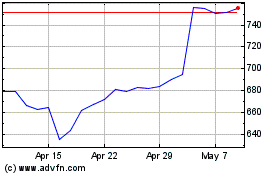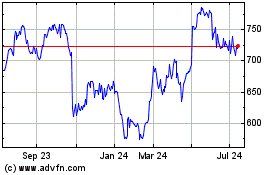Why Oil Isn't Everything to Standard Chartered -- Heard on the Street
April 26 2016 - 8:25AM
Dow Jones News
By Paul J. Davies
Many a fortune has been won and lost on oil and other stuff dug
out of the ground.
Standard Chartered is more dependent than most banks on lending
money to those who dig up commodities or move them around: that is
why its shares track the oil price closely and why commodities
drove the fears around its bad debts.
A recovery in commodities prices would mean a rebound in
revenues in a significant chunk of Standard Charter's business. But
it wouldn't cure all the bank's top-line ills.
The bank's corporate and institutional division, which contains
most of the commodities exposure, saw the biggest falls in revenues
versus the first quarter last year. They were down 27%, or $670
million, which includes not only trade finance, but also financial
markets and corporate finance.
Partly this is down to restructuring, shedding bad assets and
cutting back its risk appetite. But it is also down to cheaper
commodities. Much of the bank's commodities lending is trade
finance with short maturities, so if it stops making new loans, its
book shrinks quite quickly. That helped cut its commodities
exposure from $55 billion at the end of 2014 to $37 billion
today.
However, any new commodities financing it has done is against
lower priced material, which means smaller loans and lower
revenues. Andy Halford, chief finance officer, said perhaps
one-third of the shrinkage in commodities-related revenues was down
to lower prices, with some more related to reduced market
activity.
Assuming its risk appetite stays the same from here, there is a
decent chunk of revenues that can rebound if, for example, oil or
iron ore prices recover. This looks good for Standard Chartered,
which has less exposure than some larger European rivals to the
hard-to-shed fixed-income and derivatives businesses that no longer
work under new capital rules. When a turnaround in its wholesale
bank comes, it could be quite quick.
But other things still hold it back. Its first-quarter profits
beat expectations due to lower bad loan losses, but the bank still
added more bad loans in the period and for Bill Winters, chief
executive, it was too early to say asset quality had turned a
corner.
There have also been permanent revenue losses elsewhere. Retail
revenues, which account for about one-third of the total, were down
by 20% year on year and about half of that is gone for good because
the bank quit businesses. The smaller commercial clients business
saw a 36% drop in revenues and much of that comes from the bank
getting out of risks it no longer likes.
Standard Chartered is still shrinking and it will until there is
a rebound in commodities and Asian growth. As it grinds through its
restructuring this year, it will also need to show where the bank's
own rebound could come from.
Write to Paul J. Davies at paul.davies@wsj.com
(END) Dow Jones Newswires
April 26, 2016 08:10 ET (12:10 GMT)
Copyright (c) 2016 Dow Jones & Company, Inc.
Standard Chartered (LSE:STAN)
Historical Stock Chart
From Mar 2024 to Apr 2024

Standard Chartered (LSE:STAN)
Historical Stock Chart
From Apr 2023 to Apr 2024
